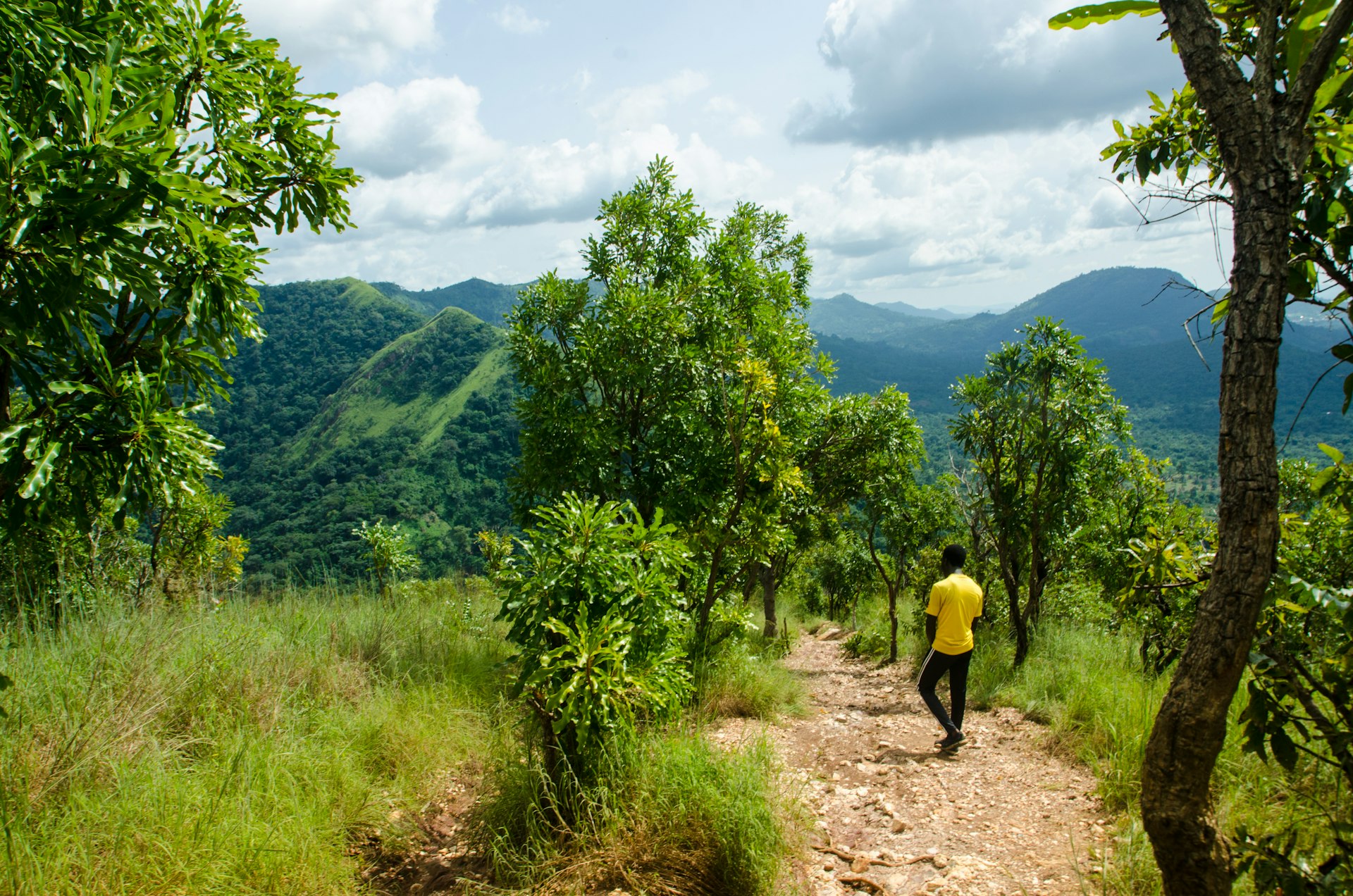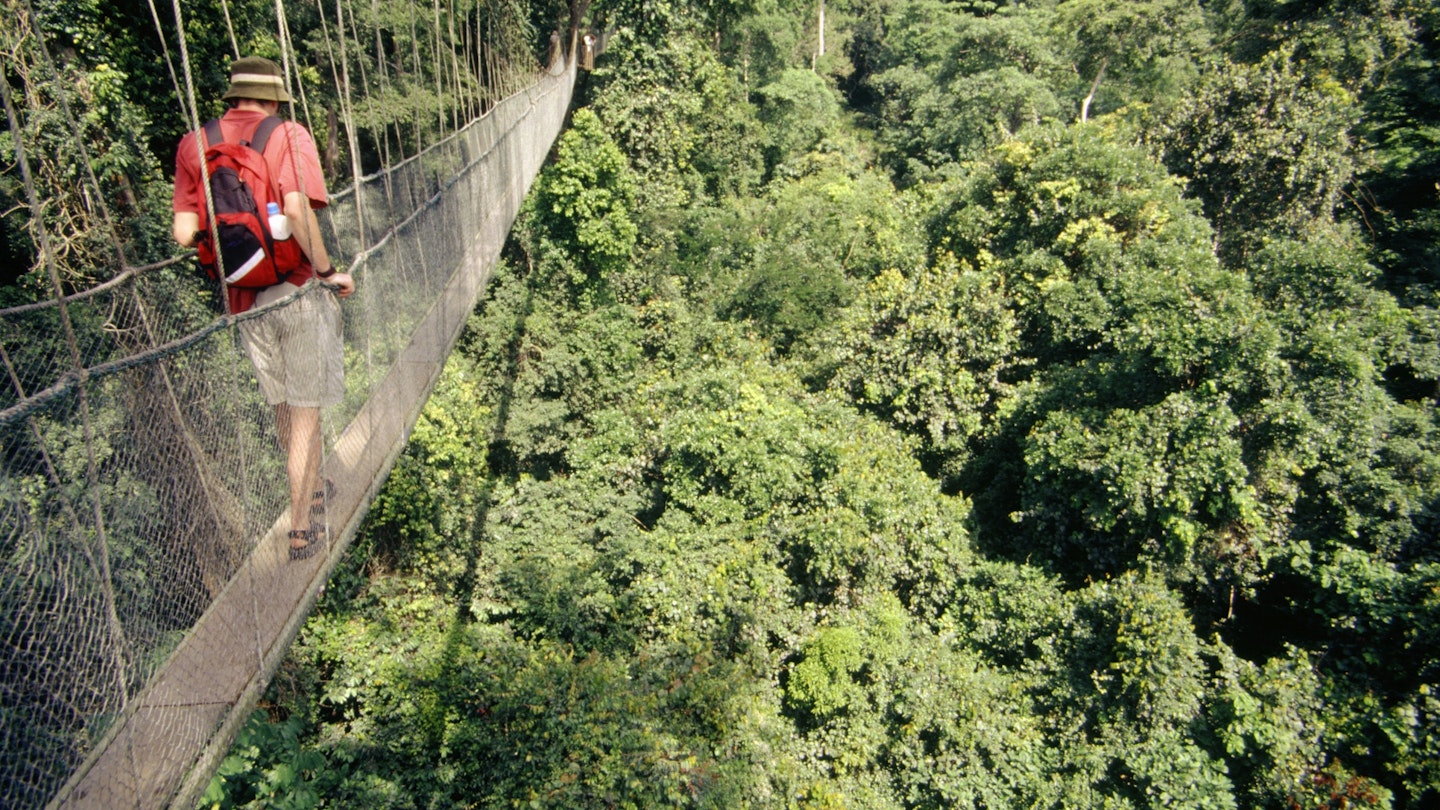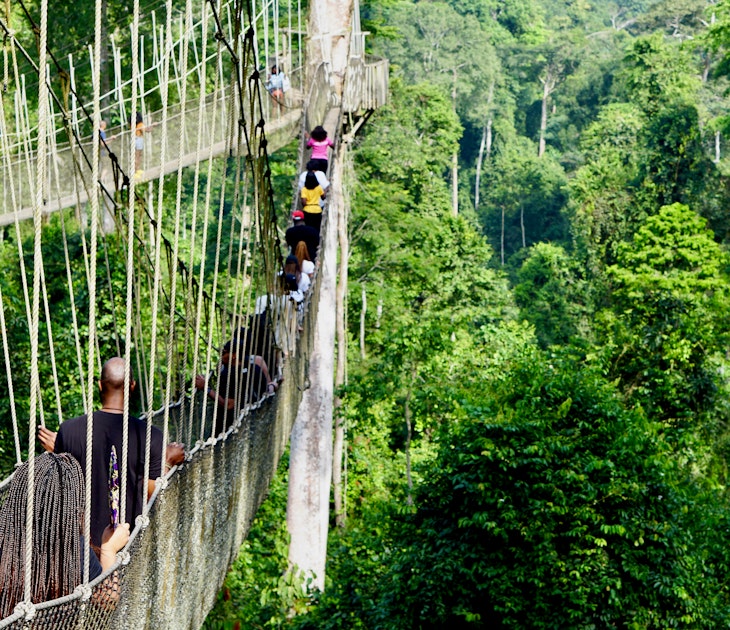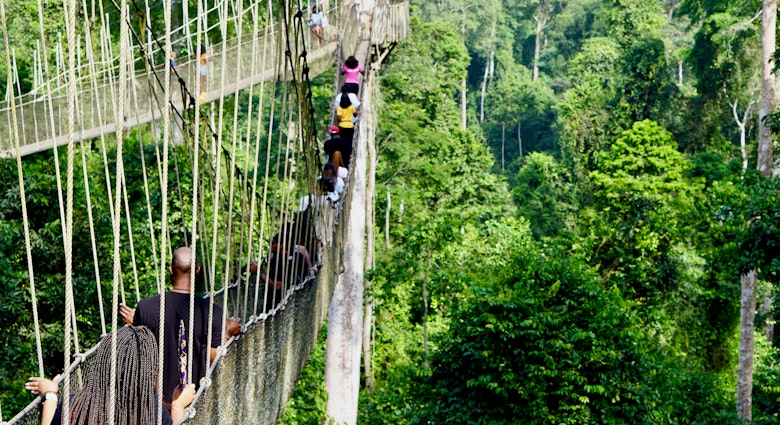Best known for its cultural offerings and important historical sites, Ghana is also home to a wealth of majestic natural parks.
These nature preserves feature everything from unspoiled rainforest to open savannas where you can track elephants on foot. If you’re lucky, you may even spot a lion or two. Get ready to experience a whole new side of this West African country by visiting five of the most remarkable national parks and conservation areas in Ghana.
Walk among the rainforest canopy at Kakum National Park
Kakum National Park is one of Ghana’s most visited attractions. The park is home to dozens of mammal species, including spot-nosed monkeys, six types of duiker and Ghana’s densest population of forest elephants (the smaller cousin of African savanna elephants). Yet the bulk of this wildlife is elusive, often camouflaging itself from onlookers among the greenery of Kakum’s vast rainforest.
Even if you don’t spot any wildlife in this 375-sq-km (145-sq-mile) national park, you’re in for a treat thanks to the 350m- (1148ft-)long canopy walk at a height of some 40m (130ft), which provides a uniquely breathtaking vantage point. This series of seven rope bridges winds its way through Kakum’s towering rainforest canopy, a world of mostly virgin hardwood trees, including ebony and mahogany. Some of the centuries-old trees grow up to 60m (200ft) tall, with flowering orchids and ferns covering their trunks and a bevy of squawking wildlife in their branches.
The park’s well-built infrastructure includes a visitor center and on-site restaurant, as well as souvenir shops where you can buy anything from hand-carved kpanlogo drums to kente-cloth dresses. Kakum is also home to a rustic treehouse that allows guests to stay the night amid the park’s many creatures. Guided treks, including night hikes, might be the best way to explore the forest, and can be booked at the visitor center upon arrival.

Enjoy superlative wildlife watching at Mole National Park
At 4840 sq km (1869 sq miles), Mole National Park is the largest of Ghana’s seven protected areas. It’s also the oldest, first established in 1958. Located in the country’s northwest Savannah region – easily accessible from Tamale Airport – Mole is one of Ghana’s most sought-after spots for wildlife watching.
Primates such as green vervet monkeys and pensive baboons make their home among the park’s open grasslands and bask in the shade of flat-topped wild syringa, African baobab, and flowering acacia and shea trees. Other mammals such as warthogs and hippos reside here as well, with martial eagles – known for their massive wingspan – can be spotted circling overhead. They’re just one of the 344 species of birds that nest or migrate here.
Although it’s possible to spot predators such as spotted hyena, leopards and even lions (so rarely seen that some consider their presence a myth), it’s the park’s elephant population that astounds the most. Mole is home to approximately 500 forest elephants that tend to gather at crocodile-filled watering holes or wander in groups among Mole’s slightly rolling landscape. Compared with other elephant populations across Africa, the park’s particular breed of elephants are considered to be non-aggressive, meaning walking safaris led by a certified guide are not just allowed here – they’re encouraged.
Game drives or a combination of jeep and walking safaris offer a great way to experience Mole; we also recommend the night at one of the onsite lodgings. Zaina Lodge features luxurious chalet-style tents, each with its own private balcony and water-hole views, while Mole Motel is simpler.

Hit the hiking trails at Kyabobo National Park
While it’s not easy to reach, Kyabobo National Park, in an under-visited part of Ghana, is well worth the effort of getting to. It’s exactly this remoteness that makes the park so alluring: expect to not see another visitor for hours, if not days.
At 220 sq km (85 sq mile) Kyabobo is home to Ghana’s second-tallest mountain peak, the 876m (2874ft) Mt Dzebobo, whose summit offers stellar panoramic views of Volta Lake. Indeed, more than half of this national park is mountainous, a unique feature for Ghana. From one of its many higher vantage points, you can look out and see the ecological transition from tropical rainforest in the park’s south to open savanna in its north. The park is a haven for hundreds of butterfly species, as well as for warthog, aardvark, baboon, and the prolific red river hogs and rock hyrax.
Kyabobo is also a great spot for both trekking and mountain biking. The park’s headquarters in Nkwanta rents out mountain bikes, perfect for tackling its rugged terrain. And its seven hiking trails include a five-hour trek up to a gushing 60m (197ft) waterfall, as well as another path that ends at a remote “hanging village” tucked away in the park’s aptly named Breast Mountains.
There have been talks to merge Kyabobo and Togo’s adjacent Fazao Malfakassa National Park into the region’s first trans-frontier park, allowing the chance for visitors to hike freely between the two. However, no definite timeline has been established.

Visit Atewa Range Forest Reserve to see endemic and critically endangered species
Atewa Range Forest Reserve is Ghana’s biggest forest, and one of the largest surviving rainforests in West Africa. This park consists of nearly 259 sq km (100 sq miles) of woodlands, including a substantial swath of upland evergreen forest, uncommon in this region. This richly biodiverse area brims with lush jungles sprouting giant ferns, clear running streams and more than 570 species of butterflies – some of which, like the Atewa dotted border, are found nowhere else on the planet.
Atewa is a refuge for an incredible array of rare plants and animals. Scientists first spotted the critically endangered white-naped mangabey, a ground-dwelling primate, here in 2017; birds like the least honeyguide and blue-headed crested-flycatcher reside in the reserve as well. The critically endangered Togo slippery frog and the newly discovered Afia Birago puddle frog (identifiable by its black-spotted throat and pointed snout) also call Atewa home.
Efforts are underway to have Atewa Range Forest Reserve declared as a national park.
Meet chimpanzees in untouched rainforest at Bia National Park
Bia National Park, Ghana’s only designated biosphere reserve, is a wonderfully biodiverse rainforest that boasts some of the country’s last remaining remnants of pristine canopy cover, including several of West Africa’s tallest trees. This Unesco-listed 306-sq-km (118-sq-mile) conservation area teems with wildlife, including elephants, buffaloes and bongos (spiral-horned, mostly nocturnal ungulates that are considered highly threatened).
It’s also home to some of Ghana's rarest wildlife finds, including the vulnerable white-breasted guinea fowl, a newly discovered lizard species known as agama sylvanus and nearly a dozen primate species including chimpanzees. Bia is one of the few areas in the country where you might spot those forest-dwelling great apes.
Camping is allowed at designated sites within the park, so bring your gear along with you.
You might also like:
How to live like a Local in Accra, Ghana
Accra's best local food (and where to find it)
West Africa's best wildlife parks









